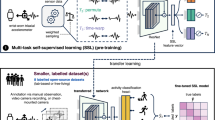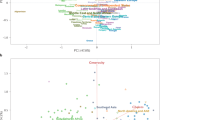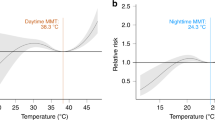Abstract
Background
Air pollution epidemiology has primarily relied on fixed outdoor air quality monitoring networks and static populations.
Methods
Taking advantage of recent advancements in sensor technologies and computational techniques, this paper presents a novel methodological approach that improves dose estimations of multiple air pollutants in large-scale health studies. We show the results of an intensive field campaign that measured personal exposures to gaseous pollutants and particulate matter of a health panel of 251 participants residing in urban and peri-urban Beijing with 60 personal air quality monitors (PAMs). Outdoor air pollution measurements were collected in monitoring stations close to the participants’ residential addresses. Based on parameters collected with the PAMs, we developed an advanced computational model that automatically classified time-activity-location patterns of each individual during daily life at high spatial and temporal resolution.
Results
Applying this methodological approach in two established cohorts, we found substantial differences between doses estimated from outdoor and personal air quality measurements. The PAM measurements also significantly reduced the correlation between pollutant species often observed in static outdoor measurements, reducing confounding effects.
Conclusions
Future work will utilise these improved dose estimations to investigate the underlying mechanisms of air pollution on cardio-pulmonary health outcomes using detailed medical biomarkers in a way that has not been possible before.
This is a preview of subscription content, access via your institution
Access options
Subscribe to this journal
Receive 6 print issues and online access
$259.00 per year
only $43.17 per issue
Buy this article
- Purchase on Springer Link
- Instant access to full article PDF
Prices may be subject to local taxes which are calculated during checkout






Similar content being viewed by others
References
Cohen AJ, Brauer M, Burnett R, Anderson HR, Frostad J, Estep K, et al. Estimates and 25-year trends of the global burden of disease attributable to ambient air pollution: an analysis of data from the Global Burden of Diseases Study 2015. Lancet 2017;389:1907–18.
World Health Organisation. Air pollution levels rising in many of the world’s poorest cities. http://www.who.int/mediacentre/news/releases/2016/air-pollution-rising/; 2016.
Özkaynak HK, Baxter LK, Dionisio KL, Burke J, Özkaynak H, Baxter LK, et al. Air pollution exposure prediction approaches used in air pollution epidemiology studies. J Exposure Sci Environ Epidemiol. 2013;23:566–72.
Committee on the Medical Effects of Air Pollutants. Associations of long-term average concentrations of nitrogen dioxide with mortality. UK: Public Health England; 2018.
Zeger SL, Thomas D, Dominici F, Samet JM, Schwartz J, Dockery D, et al. Exposure measurement error in time-series studies of air pollution: concepts and consequences. Environ Health Perspect. 2000;108:419–26.
Sarnat SE, Sarnat JA, Mulholland J, Isakov V, Özkaynak H, Chang HH, et al. Application of alternative spatiotemporal metrics of ambient air pollution exposure in a time-series epidemiological study in Atlanta. J Exposure Sci Environ Epidemiol. 2013;23:593–605.
Steinle S, Reis S, Sabel CE. Quantifying human exposure to air pollution-moving from static monitoring to spatio-temporally resolved personal exposure assessment. Sci Total Environ. 2013;443:184–93.
Karanasiou A, Viana M, Querol X, Moreno T, de Leeuw F. Assessment of personal exposure to particulate air pollution during commuting in European cities—Recommendations and policy implications. Sci Total Environ. 2014;8:785–97.
Klepeis NE, Nelson WC, Ott WR, Robinson JP, Tsang AM, Switzer P, et al. The national human activity pattern survey (NHAPS): a resource for assessing expo- sure to environmental pollutants. J Exposure Anal Environ Epidemiol. 2001;11:231–52.
Sundell J, Levin H, Nazaroff WW, Cain WS, Fisk WJ, Grimsrud DT, et al. Ventilation rates and health: multidisciplinary review of the scientific literature. Indoor Air. 2011;21:191–204.
Schweizer C, Edwards RD, Bayer-Oglesby L, Gauderman WJ, Ilacqua V, Juhani Jan- tunen M, et al. Indoor time-microenvironment-activity patterns in seven regions of Europe. J Exposure Sci Environ Epidemiol. 2007;17:170–81.
US Environmental Protection Agency (EPA). Exposure Factors Handbook: 2011 Edition. National Center for Environmental Assessment, Washington, DC. 2011. p. 1–1466.
Han Y, Chen W, Chatzidiakou L, Yan L, Zhang H, Chan Q, et al. Effects of AIR pollution on cardiopuLmonary disEaSe in urban and peri-urban reSidents in Beijing: protocol for the AIRLESS study. Atmos Chem Phys Discuss. 2020. https://acp.copernicus.org/preprints/acp-2020-208/ (In review).
Shi Z, Vu T, Kotthaus S, Harrison RM, Grimmond S, Yue S, et al. Introduction to the special issue “in-depth study of air pollution sources and processes within Beijing and its surrounding region (APHH-Beijing)”. Atmos Chem Phys. 2019;19:7519–46.
Chatzidiakou L, Krause A, Popoola OAM, Di Antonio A, Kellaway M, Han Y, et al. Characterising low-cost sensors in highly portable platforms to quantify personal exposure in diverse environments. Atmos Meas Tech. 2019;5:4643–57.
OpenStreetMap contributors. OpenStreetMap. Planet dump. https://planet.osm.org 2017.
Lyons AJ, Turner WC, Getz WM. Home range plus: aspace-time characterization of movement over real landscapes. Mov Ecol. 2013;1:2.
Spalt EW, Curl CL, Allen RW, Cohen M, Williams K, Hirsch JA, et al. Factors influencing time-location patterns and their impact on estimates of exposure: the multi-ethnic study of atherosclerosis and air pollution (MESA Air). J Exposure Sci Environ Epidemiol. 2016;26:341–8.
Ott WR. Concepts of human exposure to air pollution. Environ Int. 1982;7:179–96.
Monn C. Exposure assessment of air pollutants: a review on spatial heterogeneity and indoor/outdoor/personal exposure to suspended particulate matter, nitrogen dioxide and ozone. Atmos Environ 2001;35:1–32.
Brauer M. How much, how long, what, and where: Air pollution exposure assessment for epidemiologic studies of respiratory disease. Proc Am Thorac Soc. 2010;7:111–5.
De Nazelle A, Seto E, Donaire-Gonzalez D, Mendez M, Matamala J, Nieuwenhuijsen MJ, et al. Improving estimates of air pollution exposure through ubiquitous sensing technologies. Environ Pollut. 2013;5:92–99.
Calenge C. Analysis of animal movements in R: the adehabitatLT package. Vienna: R Foundation for Statistical Computing; 2011.
Acknowledgements
We would like to thank all members of the AIRLESS team who helped during fieldwork in urban Beijing and peri-urban sites. We would also like to thank the AIRPOLL and AIRPRO study team for the collected ambient air pollution data for reference calibration and further health analysis.
AIRLESS team
Ben Barratt2,4,9, Yutong Cai2, Queenie Chan2, Lia Chatzidiakou1, Shiyi Chen3, Wu Chen3, Xi Chen3, Paul Elliott2, Majid Ezzati2, Yunfei Fan3, Xueyu Han7, Yiqun Han2,3,4, Min Hu3,8, Aoming Jin6, Roderic L. Jones1, Frank J. Kelly2,4,9, Anika Krause1, Yingruo Li3, Pengfei Liang3, Jing Liu7, Yan Luo6, Xinghua Qiu3, Qi Wang3, Teng Wang3, Yanwen Wang3, Yangfeng Wu6, Gaoqiang Xie6, Wuxiang Xie6, Tao Xue3, Li Yan2,4, Hanbin Zhang2, Junfeng Zhang10, Meiping Zhao11, Tong Zhu3,8, Yidan Zhu6
Funding
This project is funded under the Newton Fund Programme awarded by Natural Environmental Research Council (NERC Grant NE/N007018/1) with support from Medical Research Council (MRC) and by the National Natural Science Foundation of China (NSFC Grant 81571130100). The NSFC funding is mainly used to support the field work in China, and NERC funding is mainly used for coordination and the further analysis.
Author information
Authors and Affiliations
Consortia
Contributions
LC and AK have contributed equally to this paper. It was conceptualised by LC, AK and RLJ. The sensor platform was developed by MK and LC. The field deployment was performed by LC, AK, YH, LY, WC and the AIRLESS team. The PIs of the two cohorts were YW and JL. MH was in charge of the Peking University monitoring station. The data curation was performed by LC and AK. LC, AK, OAMP and RLJ contributed to the formal data analysis. Data were visualised by AK and LC. Resources were provided by BB, FJK, TZ and RLJ. The original draft was written by LC and AK and reviewed and edited by YH, BB and RLJ.
Corresponding author
Ethics declarations
Conflict of interest
The study protocol was approved by the Institutional Review Board of the Peking University Health Science Centre, China (IRB00001052-16028), and College Research Ethics Committee of King’s College London, UK (HR-16/17-3901). Informed consent was obtained from all subjects.The authors declare no conflict of interest.
Ethics approval
The study protocol was approved by the Institutional Review Board of the Peking University Health Science Centre, China (IRB00001052-16028), and College Research Ethics Committee of King’s College London, UK (HR-16/17-3901). Informed consent was obtained from all subjects.
Additional information
Publisher’s note Springer Nature remains neutral with regard to jurisdictional claims in published maps and institutional affiliations.
Members of the AIRLESS team are listed below Acknowledgements.
Supplementary information
Rights and permissions
About this article
Cite this article
Chatzidiakou, L., Krause, A., Han, Y. et al. Using low-cost sensor technologies and advanced computational methods to improve dose estimations in health panel studies: results of the AIRLESS project. J Expo Sci Environ Epidemiol 30, 981–989 (2020). https://doi.org/10.1038/s41370-020-0259-6
Received:
Accepted:
Published:
Issue Date:
DOI: https://doi.org/10.1038/s41370-020-0259-6
Keywords
This article is cited by
-
Linking environmental risk factors with epigenetic mechanisms in Parkinson’s disease
npj Parkinson's Disease (2023)
-
Automated classification of time-activity-location patterns for improved estimation of personal exposure to air pollution
Environmental Health (2022)



